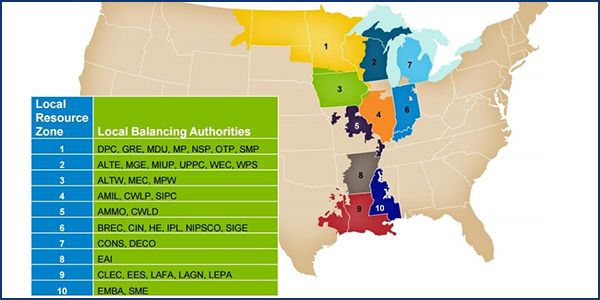By Amanda Durish Cook
CARMEL, Ind. — Early data for MISO’s spring capacity auction shows a 1-GW uptick in the RTO’s capacity supply needs but essentially no change in year-over-year peak forecasts.
MISO forecasts a 121.6-GW systemwide coincident peak and a nearly 136-GW planning reserve margin requirement for 2020/21. The peak forecast is identical to last year’s early prediction, which was later upped to 122 GW. (See MISO Preliminary PRA Data up Slightly from Early Prediction.)
The zonal coincident peak forecast is predicted to be slightly more than 125 GW, also nearly identical to last year’s estimate. MISO also noted that coincident peak forecasts “across the footprint were flat or showed slight decreases.”
“The numbers are very similar to last year’s. This is the second year that we haven’t seen meaningful increases or decreases,” Tim Bachus, MISO capacity market administration analyst, said at a Resource Adequacy Subcommittee meeting Wednesday.
However, zonal reserve margin requirements are up slightly because of a 1% increase in the overall margin from 2019/20. (See MISO Planning Reserve Margin to Climb in 2020.) Local clearing requirements increased by less than 200 MW in half of MISO’s 10 local resource zones. The RTO last year estimated an almost 135-GW planning reserve margin requirement.
Bachus said fuller and updated predictions will be presented at the March RASC meeting.
MISO also released updated subregional import and export constraints for transmission linking the Midwest and South for the 2020/21 Planning Resource Auction. The RTO is limited to directional flows of 3,000 MW southbound and 2,500 MW northbound, but it conducts annual feasibility studies on the limits and reduces flows according to firm transmission reservations.
MISO said the southbound flow limit will remain unchanged at 3,000 MW this year, but the northbound limit will be 1,900 MW, an increase of 400 MW from last year’s flow cap of 1,500 MW based on the feasibility study. The RTO reported 600 MW worth of transmission service requests in the northbound direction.
MISO Manager of Capacity Market Administration Eric Thoms said firm transmission requests that expired last year will allow more capacity across the limit in the upcoming planning year.





